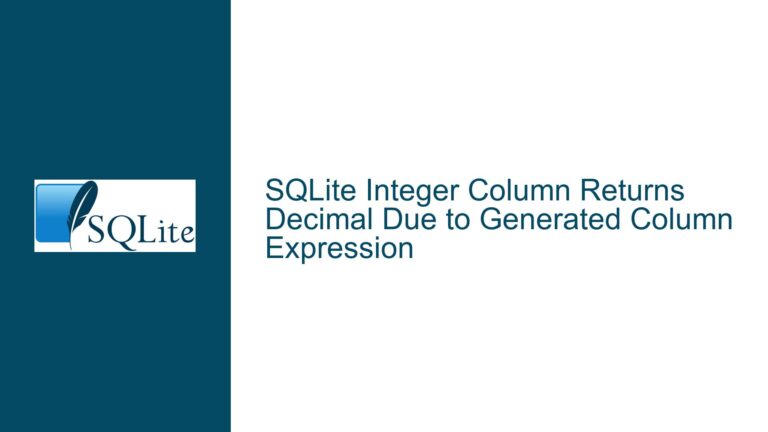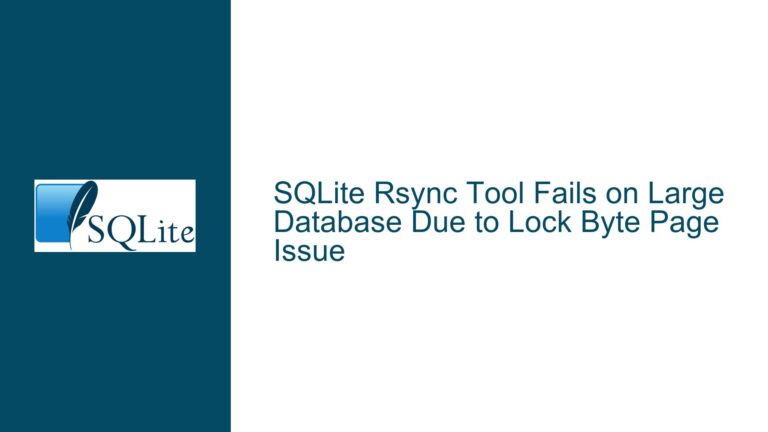SQLite DROP VIEW IF EXISTS Fails When Table Exists and Vice Versa
DROP VIEW IF EXISTS Fails When a Table of the Same Name Exists
The issue at hand revolves around the behavior of the DROP VIEW IF EXISTS and DROP TABLE IF EXISTS statements in SQLite when a table or view of the same name exists. Specifically, the problem arises when attempting to drop a view using DROP VIEW IF EXISTS while a table with the same name exists, or vice versa. The error messages returned by SQLite in these scenarios are:
Error: use DROP TABLE to delete table xxx Unable to execute statement.Error: use DROP VIEW to delete view yyy Unable to execute statement.
These errors occur because SQLite enforces strict type checking when dropping objects. If a table named xxx exists, attempting to drop a view named xxx using DROP VIEW IF EXISTS will fail, even if no view named xxx exists. Similarly, if a view named yyy exists, attempting to drop a table named yyy using DROP TABLE IF EXISTS will fail, even if no table named yyy exists.
This behavior is counterintuitive to many developers, especially those who expect the IF EXISTS clause to suppress errors when the object being dropped does not exist, regardless of the object type. The expectation is that DROP VIEW IF EXISTS should succeed if no view of that name exists, irrespective of whether a table of the same name exists. The same logic applies to DROP TABLE IF EXISTS.
SQLite’s Object Type Enforcement in DROP Statements
The root cause of this issue lies in SQLite’s handling of object types during the execution of DROP statements. SQLite maintains a strict separation between tables and views, treating them as distinct entities even if they share the same name. When a DROP VIEW statement is executed, SQLite explicitly checks for the existence of a view with the specified name. If a table with the same name exists, SQLite does not consider it a match and instead throws an error, indicating that the object being dropped is of the wrong type.
This behavior is consistent with SQLite’s documentation, which states that "objects of types that cannot be used in the context of the reference are always ignored." However, this interpretation leads to confusion when the IF EXISTS clause is used. Developers expect the IF EXISTS clause to make the statement idempotent, meaning that the statement should have no effect if the object does not exist, regardless of the object type.
The issue is further compounded by the fact that SQLite does not allow a table and a view to share the same name within the same database. This restriction ensures that object names are unique within their respective types, but it also means that the DROP statements must be precise in their object type specification. If a table and a view could share the same name, the DROP statements would need to be even more explicit in their type enforcement.
Implementing Workarounds and Best Practices for Dropping Objects
To address this issue, developers can adopt several strategies to ensure that their DROP statements behave as expected, even in the presence of objects with conflicting types. These strategies involve careful management of object names, the use of conditional logic, and the implementation of robust error handling.
Conditional Object Dropping
One approach is to use conditional logic to check the type of the object before attempting to drop it. This can be achieved by querying the sqlite_master table, which contains metadata about all objects in the database. The following example demonstrates how to conditionally drop a view or table based on its type:
-- Check if a view named 'xxx' exists
SELECT COUNT(*) FROM sqlite_master WHERE type = 'view' AND name = 'xxx';
-- If the view exists, drop it
DROP VIEW IF EXISTS 'xxx';
-- Check if a table named 'xxx' exists
SELECT COUNT(*) FROM sqlite_master WHERE type = 'table' AND name = 'xxx';
-- If the table exists, drop it
DROP TABLE IF EXISTS 'xxx';
This approach ensures that the correct DROP statement is executed based on the type of the object, avoiding the errors caused by type mismatches.
Using Transactions for Atomic Operations
Another strategy is to use transactions to ensure that the dropping of objects is performed atomically. This is particularly useful in scenarios where multiple objects need to be dropped, and the presence of conflicting types could lead to partial execution. By wrapping the DROP statements in a transaction, developers can ensure that either all objects are dropped successfully, or none are dropped at all.
BEGIN TRANSACTION;
-- Drop the view if it exists
DROP VIEW IF EXISTS 'xxx';
-- Drop the table if it exists
DROP TABLE IF EXISTS 'xxx';
COMMIT;
If any of the DROP statements fail, the transaction can be rolled back, ensuring that the database remains in a consistent state.
Implementing Custom Drop Functions
For more complex scenarios, developers can implement custom drop functions that handle the dropping of objects based on their type. These functions can be written in a procedural language such as PL/SQL or Python, depending on the environment in which SQLite is being used. The following example demonstrates a custom drop function written in Python:
import sqlite3
def drop_object_if_exists(conn, object_name):
cursor = conn.cursor()
# Check if a view with the specified name exists
cursor.execute("SELECT COUNT(*) FROM sqlite_master WHERE type = 'view' AND name = ?", (object_name,))
if cursor.fetchone()[0] > 0:
cursor.execute(f"DROP VIEW IF EXISTS {object_name}")
# Check if a table with the specified name exists
cursor.execute("SELECT COUNT(*) FROM sqlite_master WHERE type = 'table' AND name = ?", (object_name,))
if cursor.fetchone()[0] > 0:
cursor.execute(f"DROP TABLE IF EXISTS {object_name}")
conn.commit()
# Usage example
conn = sqlite3.connect('example.db')
drop_object_if_exists(conn, 'xxx')
This custom function checks the type of the object before attempting to drop it, ensuring that the correct DROP statement is executed.
Best Practices for Object Management
To avoid issues with conflicting object types, developers should adopt best practices for object management in SQLite. These practices include:
Unique Naming Conventions: Ensure that tables and views have unique names within the database. This can be achieved by using prefixes or suffixes to distinguish between different types of objects.
Consistent Object Creation and Deletion: Always create and delete objects in a consistent manner, ensuring that the correct type is specified in each operation.
Regular Database Maintenance: Periodically review and clean up the database schema to remove unused or redundant objects. This reduces the likelihood of encountering conflicts when dropping objects.
Documentation and Code Reviews: Document the schema and object management procedures, and conduct regular code reviews to ensure that all team members are aware of the best practices.
By following these strategies and best practices, developers can mitigate the issues caused by SQLite’s strict type enforcement in DROP statements and ensure that their database operations are performed smoothly and efficiently.
Conclusion
The behavior of DROP VIEW IF EXISTS and DROP TABLE IF EXISTS in SQLite when a table or view of the same name exists can be problematic for developers who expect the IF EXISTS clause to suppress errors regardless of the object type. This issue stems from SQLite’s strict enforcement of object types during the execution of DROP statements. By understanding the root cause of this behavior and implementing the strategies outlined above, developers can work around these limitations and ensure that their database operations are performed as intended. Adopting best practices for object management and using conditional logic, transactions, and custom drop functions can help mitigate the issues and maintain a consistent and reliable database schema.






